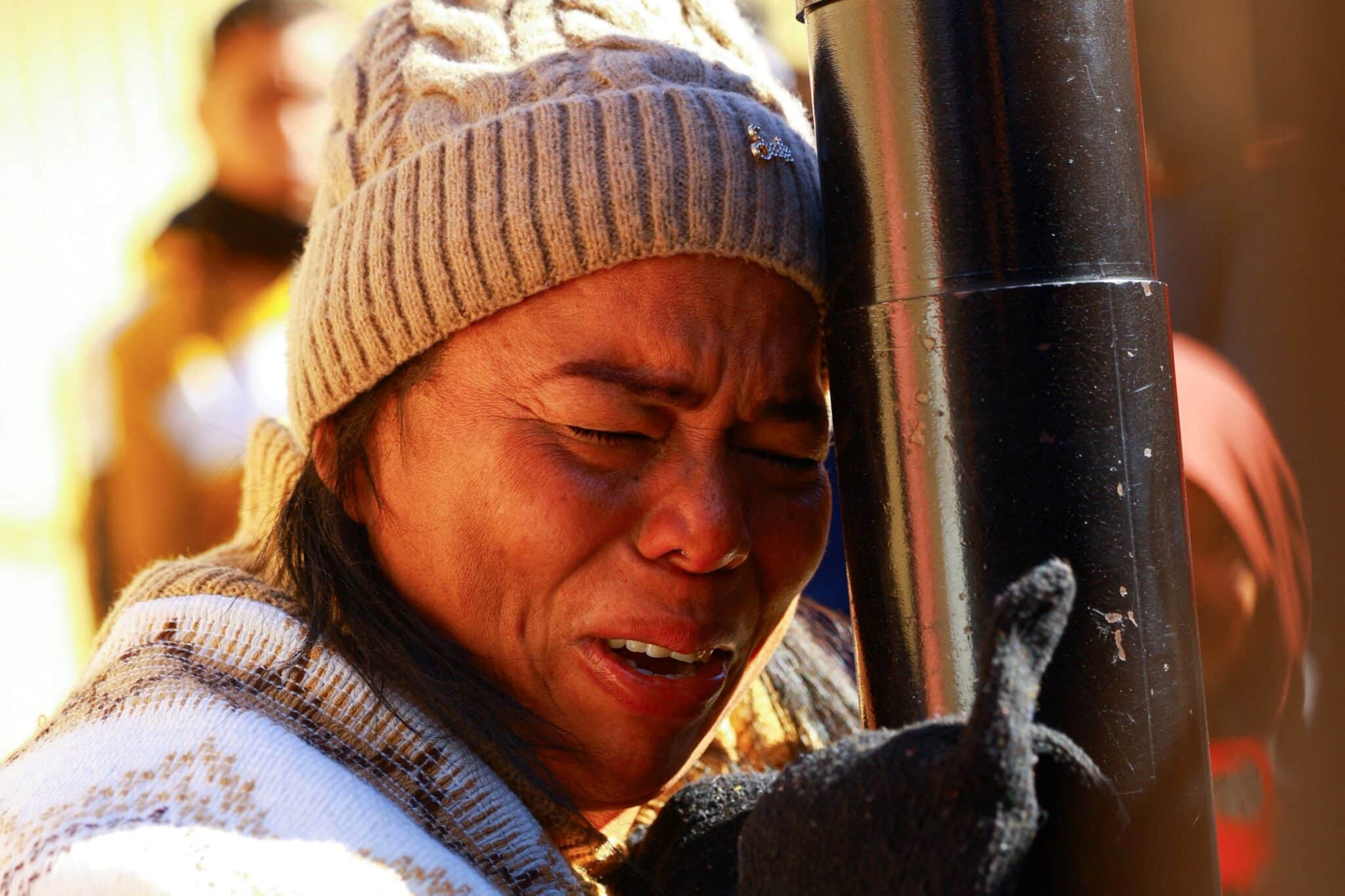VATICAN CITY (CNS) — The substitute secretary for general affairs in the Vatican Secretariat of State said Vatican officials “were forced” into spending $17 million rather than an anticipated $2 million to $4 million to buy out an Italian broker over a London property deal.
“It caused me deep pain to find that we still had to give money for this affair,” testified Archbishop Edgar Peña Parra, who serves as “substitute,” the No. 3 position in the Secretariat of State, during a Vatican trial March 16.
Gianluigi Torzi, the Italian broker who has been accused by the Vatican of fraud, embezzlement and a variety of other financial crimes, “had all the power and we couldn’t do it any other way,” Archbishop Peña said during testimony as a witness for the defense.
“It was a Way of the Cross, actually a double Way of the Cross. If the Lord fell three times, we fell six,” he said.
Ten people are on trial in the Vatican, facing multiple charges related to financial malfeasance, particularly regarding the Vatican Secretariat of State’s investment in a property on Sloane Avenue in London. The Vatican lost more than $200 million on the deal.
Between 2014 and 2018, it is believed the Vatican Secretariat of State invested 200 million euros (more than $240 million at the time) to purchase the London property. Additionally, payments to brokers and debts collected on the property raised the total investment to 350 million euros.
Archbishop Peña was appointed Vatican substitute secretary for general affairs in mid-2018, and testified March 16 that he only learned of the property deal and its problems “gradually” after his appointment.
He said by November 2018 he became concerned with what he was learning, particularly that another Vatican official, Msgr. Alberto Perlasca, the former head of the Secretariat of State’s administrative office, had already signed agreements with Torzi, which gave the broker effective control of the property. The archbishop said the monsignor signed the contracts without having signing authority and without any authorization from his superiors.
However, Archbishop Peña said he was reassured when his questions about the deal were answered by Nicola Squillace, an Italian lawyer who had been “sold as our lawyer” who held the Vatican’s best interests at heart.
When they brought the matter for review to the office of the auditor general, the head auditor, Alessandro Cassinis Righini pointed out the problems, the archbishop said.
However, “we still went ahead” with the deal because they had been reassured by Squillace, the archbishop said. “I say we because Cardinal Pietro Parolin (Vatican secretary of state) had seen the memo and said, ‘If it is as they presented it to you, let’s proceed.'”
However, a month later, Pope Francis met with the archbishop and two other Italian lawyers who explained the agreement with Torzi “had not helped: We had acquired empty boxes” and “that everything was an absolute deception.”
The pope’s advice was to “start over again and lose as little money as possible,” he said.
They decided against Msgr. Perlasca’s suggestion to file a lawsuit against Torzi because of the amount of time the litigation would take and the uncertainty of its outcome and they instead chose to “negotiate,” the archbishop said.
The idea was to oust Torzi from managing the property in order to buy it back 100%, he said, and they anticipated it would cost $2 million or at most $4 million, at the time, to buy him out. However, Torzi asked for 25 million euros, then 20 million, finally settling on 15 million euros ($17 million in 2018).
Archbishop Peña then sought a 150 million euro loan from the Vatican bank to renegotiate the mortgage on the property. While the bank initially agreed, it later flagged the affair as suspicious to Vatican prosecutors, which launched an investigation and current trial.
The archbishop was cross-examined March 17 to provide greater detail about his actions linked to his fear the bank might have been influenced by Torzi when it denied the loan and their attempts at finding financing elsewhere.
The president of the Vatican tribunal, Giuseppe Pignatone, asked the archbishop to confirm that he had authorized a series of Vatican bank transfers amounting to 575,000 euros (more than $600,000 today) to a company account named Logsinc.
The archbishop said he only agreed to authorize it after talking to Pope Francis who gave his approval and after getting an explanation from Cardinal Angelo Becciu who had first started these payments. The cardinal is on trial at the Vatican for financial malfeasance.
Archbishop Peña said the cardinal explained the money was for the release of a kidnapped nun and that he had no idea the money was going to Cecilia Marogna, whom investigators have said used the money on personal travel and buying luxury goods.
During the trial March 17, Cardinal Becciu also released a lengthy follow-up statement to the court, declaring, “I am not a manipulator, I have never manipulated anyone, least of all the Holy Father.”
It was in response to correspondence between the pope and Cardinal Becciu that Alessandro Diddi, the Vatican prosecutor, entered into evidence March 9.
The exchange of letters showed that the cardinal tried to get Pope Francis to sign statements saying the cardinal acted with the pope’s approval when he used Vatican money to invest in a property in London and when he paid Marogna who claimed she could help secure the release of a kidnapped nun.
Cardinal Becciu said March 17 that Diddi “partially” disclosed the correspondence March 9 because it was missing his first letter to the pope dated July 20. He said the letters were meant to stay private since they contained “sensitive” information about the so-called “humanitarian operation,” that is, the liberation of the nun in Mali.
Diddi had told the court March 9 that he secured copies of the letters that were from the pope and had the pope’s authorization to enter them into evidence.
By Carol Glatz | Catholic News Service







News & Commentary
Top Vatican official says London property deal was a ‘Via Crucis’
VATICAN CITY (CNS) — The substitute secretary for general affairs in the Vatican Secretariat of State said Vatican officials “were forced” into spending $17 million rather than an anticipated $2 million to $4 million to buy out an Italian broker over a London property deal.
“It caused me deep pain to find that we still had to give money for this affair,” testified Archbishop Edgar Peña Parra, who serves as “substitute,” the No. 3 position in the Secretariat of State, during a Vatican trial March 16.
Gianluigi Torzi, the Italian broker who has been accused by the Vatican of fraud, embezzlement and a variety of other financial crimes, “had all the power and we couldn’t do it any other way,” Archbishop Peña said during testimony as a witness for the defense.
“It was a Way of the Cross, actually a double Way of the Cross. If the Lord fell three times, we fell six,” he said.
Ten people are on trial in the Vatican, facing multiple charges related to financial malfeasance, particularly regarding the Vatican Secretariat of State’s investment in a property on Sloane Avenue in London. The Vatican lost more than $200 million on the deal.
Between 2014 and 2018, it is believed the Vatican Secretariat of State invested 200 million euros (more than $240 million at the time) to purchase the London property. Additionally, payments to brokers and debts collected on the property raised the total investment to 350 million euros.
Archbishop Peña was appointed Vatican substitute secretary for general affairs in mid-2018, and testified March 16 that he only learned of the property deal and its problems “gradually” after his appointment.
He said by November 2018 he became concerned with what he was learning, particularly that another Vatican official, Msgr. Alberto Perlasca, the former head of the Secretariat of State’s administrative office, had already signed agreements with Torzi, which gave the broker effective control of the property. The archbishop said the monsignor signed the contracts without having signing authority and without any authorization from his superiors.
However, Archbishop Peña said he was reassured when his questions about the deal were answered by Nicola Squillace, an Italian lawyer who had been “sold as our lawyer” who held the Vatican’s best interests at heart.
When they brought the matter for review to the office of the auditor general, the head auditor, Alessandro Cassinis Righini pointed out the problems, the archbishop said.
However, “we still went ahead” with the deal because they had been reassured by Squillace, the archbishop said. “I say we because Cardinal Pietro Parolin (Vatican secretary of state) had seen the memo and said, ‘If it is as they presented it to you, let’s proceed.'”
However, a month later, Pope Francis met with the archbishop and two other Italian lawyers who explained the agreement with Torzi “had not helped: We had acquired empty boxes” and “that everything was an absolute deception.”
The pope’s advice was to “start over again and lose as little money as possible,” he said.
They decided against Msgr. Perlasca’s suggestion to file a lawsuit against Torzi because of the amount of time the litigation would take and the uncertainty of its outcome and they instead chose to “negotiate,” the archbishop said.
The idea was to oust Torzi from managing the property in order to buy it back 100%, he said, and they anticipated it would cost $2 million or at most $4 million, at the time, to buy him out. However, Torzi asked for 25 million euros, then 20 million, finally settling on 15 million euros ($17 million in 2018).
Archbishop Peña then sought a 150 million euro loan from the Vatican bank to renegotiate the mortgage on the property. While the bank initially agreed, it later flagged the affair as suspicious to Vatican prosecutors, which launched an investigation and current trial.
The archbishop was cross-examined March 17 to provide greater detail about his actions linked to his fear the bank might have been influenced by Torzi when it denied the loan and their attempts at finding financing elsewhere.
The president of the Vatican tribunal, Giuseppe Pignatone, asked the archbishop to confirm that he had authorized a series of Vatican bank transfers amounting to 575,000 euros (more than $600,000 today) to a company account named Logsinc.
The archbishop said he only agreed to authorize it after talking to Pope Francis who gave his approval and after getting an explanation from Cardinal Angelo Becciu who had first started these payments. The cardinal is on trial at the Vatican for financial malfeasance.
Archbishop Peña said the cardinal explained the money was for the release of a kidnapped nun and that he had no idea the money was going to Cecilia Marogna, whom investigators have said used the money on personal travel and buying luxury goods.
During the trial March 17, Cardinal Becciu also released a lengthy follow-up statement to the court, declaring, “I am not a manipulator, I have never manipulated anyone, least of all the Holy Father.”
It was in response to correspondence between the pope and Cardinal Becciu that Alessandro Diddi, the Vatican prosecutor, entered into evidence March 9.
The exchange of letters showed that the cardinal tried to get Pope Francis to sign statements saying the cardinal acted with the pope’s approval when he used Vatican money to invest in a property in London and when he paid Marogna who claimed she could help secure the release of a kidnapped nun.
Cardinal Becciu said March 17 that Diddi “partially” disclosed the correspondence March 9 because it was missing his first letter to the pope dated July 20. He said the letters were meant to stay private since they contained “sensitive” information about the so-called “humanitarian operation,” that is, the liberation of the nun in Mali.
Diddi had told the court March 9 that he secured copies of the letters that were from the pope and had the pope’s authorization to enter them into evidence.
By Carol Glatz | Catholic News Service